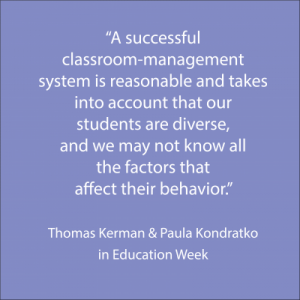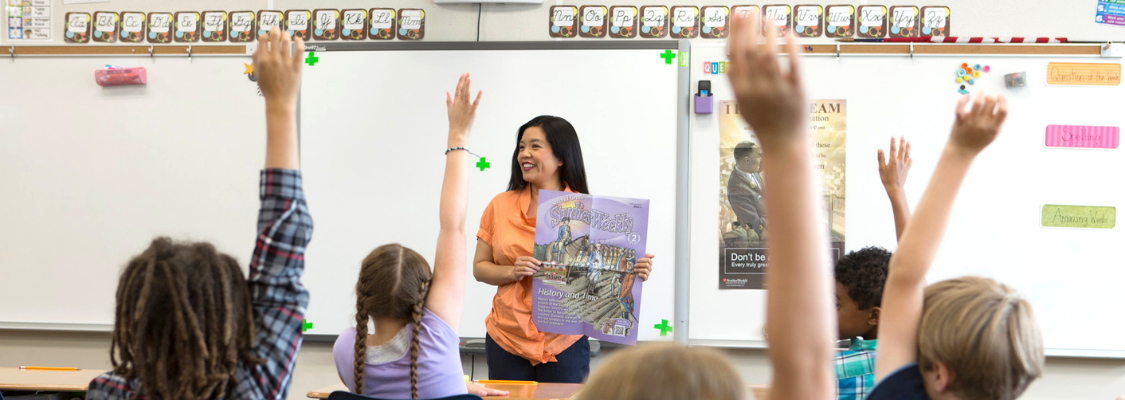Curbing Off-Task Behavior through Positive Teacher Behavior and Classroom Management
As this school year gets underway, teachers who want a consistently good year institute straightforward, steady classroom management.
Too many new teachers assume children instinctively know how to behave — that they’ve learned the way a classroom runs in prior grades, or are so used to school they inherently know what to do. But kids must navigate between different behavior expectations at home, on a sports team, or in the community, and they don’t always remember and understand the type of behavior needed within a classroom setting.
They also are still developing in their own self-management. As such, behavior expectations should be taught and modeled.
Jennifer Lasater, an international teacher and curriculum leader, starts every school year very clearly teaching classroom procedures and expectations — everything from how to line up to how to pass in papers.
 “One of the biggest mistakes I have made in my classroom has been not setting clear expectations from the beginning. My first several years of teaching I would not teach the students my expectations,” she explained in a Feb. 13, 2019 Education Week article. “I have since learned that if you expect them to perform in a certain way, you need to teach them and have them practice that expectation. Now I start the first few weeks of school just practicing routine expectations and classroom procedures.”
“One of the biggest mistakes I have made in my classroom has been not setting clear expectations from the beginning. My first several years of teaching I would not teach the students my expectations,” she explained in a Feb. 13, 2019 Education Week article. “I have since learned that if you expect them to perform in a certain way, you need to teach them and have them practice that expectation. Now I start the first few weeks of school just practicing routine expectations and classroom procedures.”
Teacher behavior modeling is an essential part of this teaching, according to education experts. If teachers do not exhibit behavior that contributes to the learning environment, students notice and respond.
A 2010 Journal of Abnormal Child Psychology study found that teachers’ verbal positive reinforcement, as opposed to their negative remarks, significantly improved students’ on-task behaviors over the course of a school year.
This study compared second and third grade teachers using the Good Behavior Game versus a control group who did not. The Good Behavior Game is a research-backed team-based classroom behavior management strategy that helps students learn positive behavior and how to work together to create a safe learning environment.
In both groups, negative teacher remarks were statistically linked to higher rates of off-task behavior. But in the GBG group, as those teachers learned to positively reinforce good behaviors, their students’ disruptive behaviors decreased over the school year. At the same time, disruptive behaviors increased over the school year in the control group.
As the study’s authors concluded: “Our results demonstrate that reductions in negative teacher management behaviors are linked with reductions in children’s disruptive behaviors, thus underscoring the potential of guiding teachers in using effective classroom management strategies.”
But when you’re one teacher wrangling 25-30 unique little individuals and trying to impart important subject matter to them, how do you model good teacher behavior?
One education expert, national-board-certified teacher Rita Platt, explained that teachers need to change their approach to behavior management. And it needs to start within the teacher.
“Start any classroom management and student discipline from a place of love, not a place of power,” she said in a Feb. 11, 2019 Education Week article.
Diane Mora, an ESL program writer, echoed that sentiment.
“Mindfulness in the classroom simply begins from the premise that students and teachers can learn and support each other in learning to self-regulate behaviors that contribute to positive, egalitarian, and safe learning environments,” she said in the Feb. 13 article.
Peg Grafwallner, an instructional coach, also cautioned that teachers need to be leaders of their students, not friends. She shared her early student-teaching mistake of wanting her students to like her, without setting solid expectations.
“I tried to create a classroom where we were a community, not necessarily realizing that structure needs to be implemented before community,” she said in the Feb. 11 article, explaining that focused professionalism in the teacher is essential to creating a classroom community.
“Our students need teacher-leaders, ones who are professional and focused. Be the teacher-leader who creates a structured classroom of choice, opportunity, and meaning. That’s how you become a teacher-friend,” she concluded.
For many teachers, classroom management is a struggle. We often juggle the excitement we have for our subject, for learning and for our students, while ensuring we have efficient crowd control to support learning. But as the teacher-leader, we have the power to make this a most excellent year.
To test yourself to see which negative teacher behaviors are creeping into your instruction, visit “Are Teachers the Culprits Behind Poor Behavior?” at teachervision.com.
To learn more tips and tricks for engaging students in learning, visit the training tab at online.studiesweekly.com.
